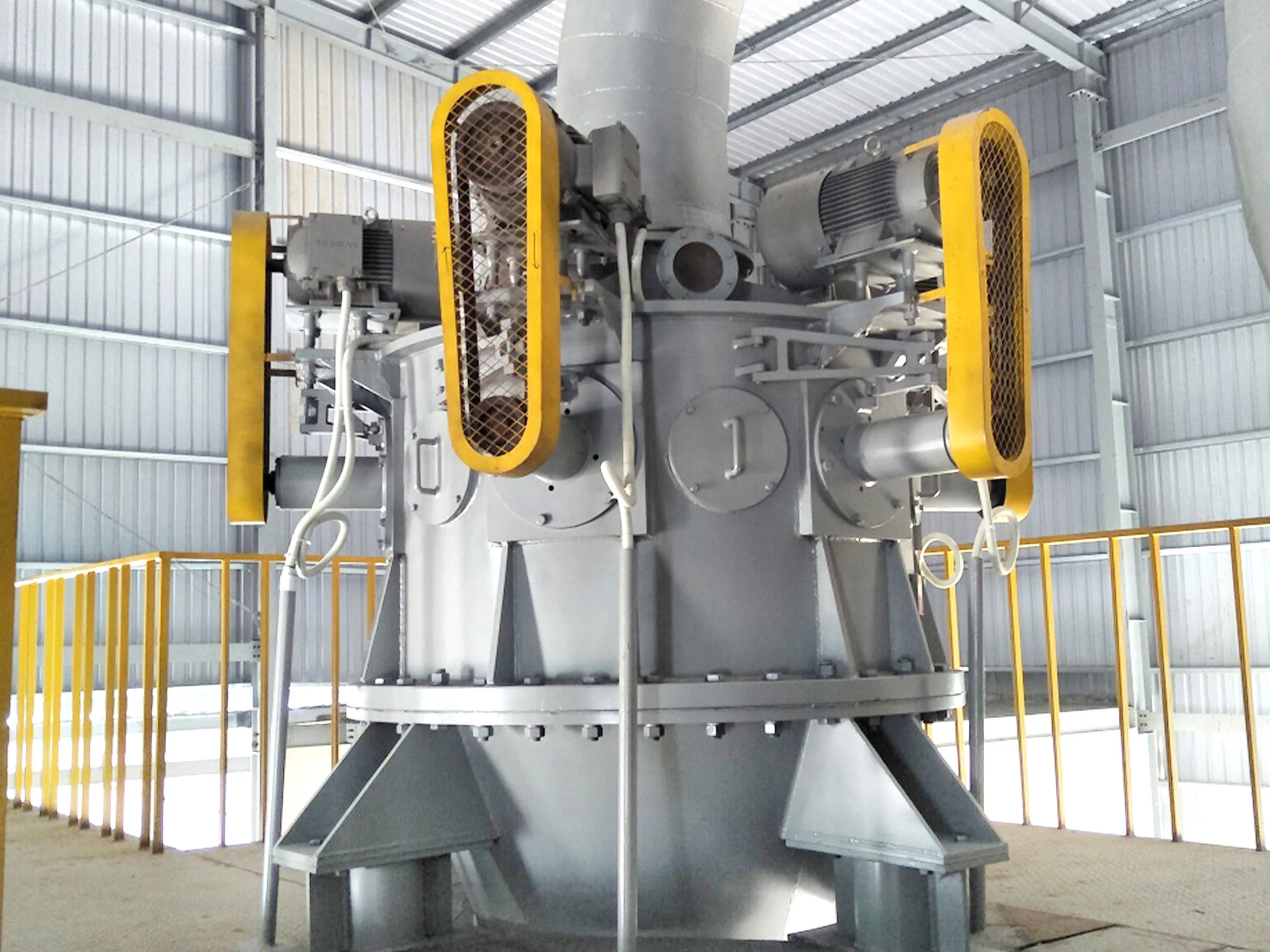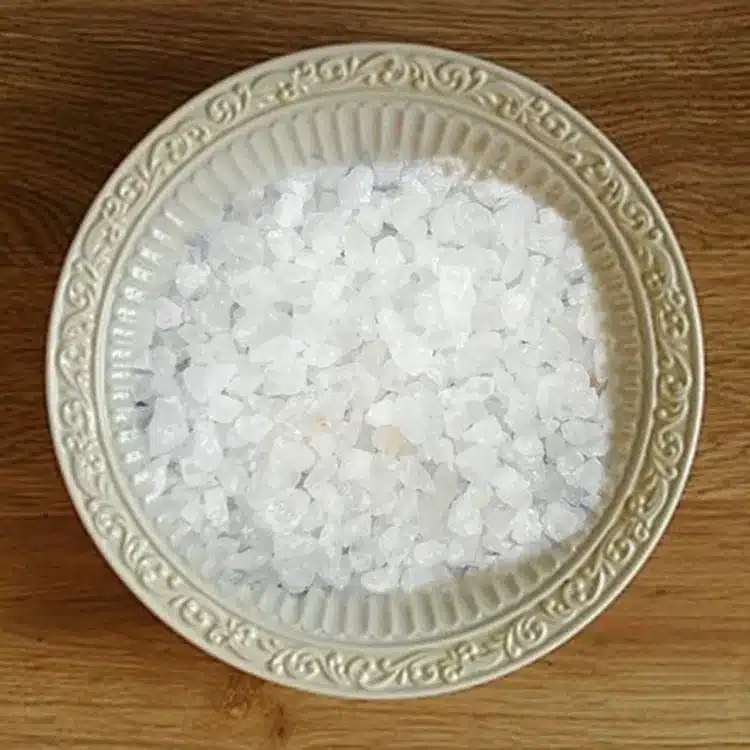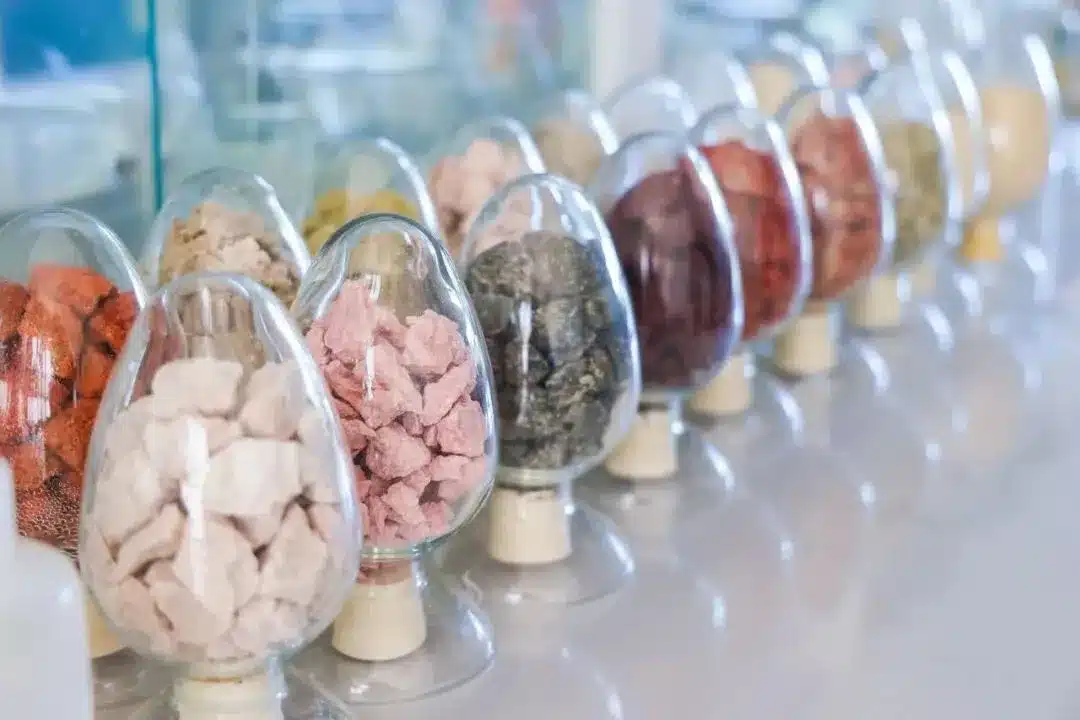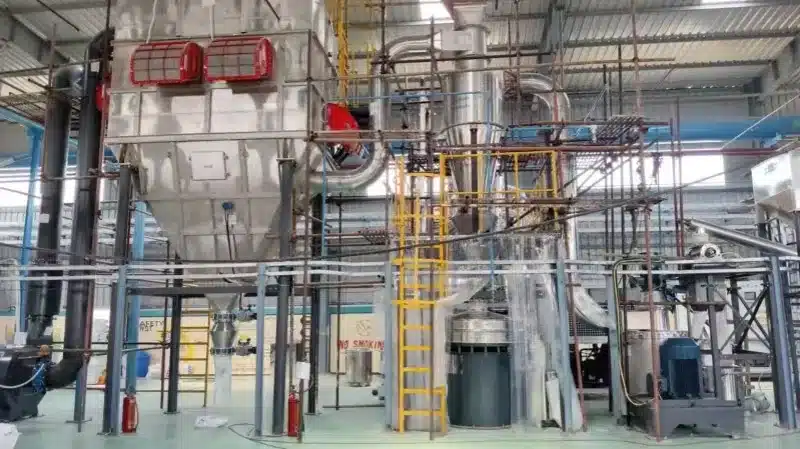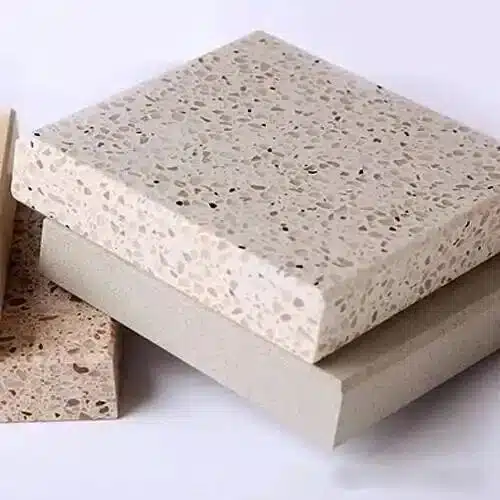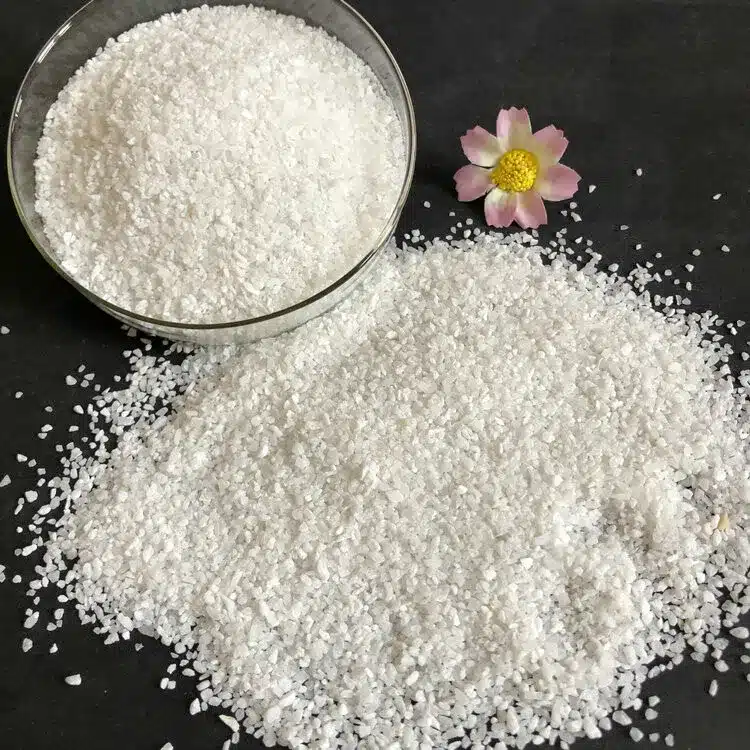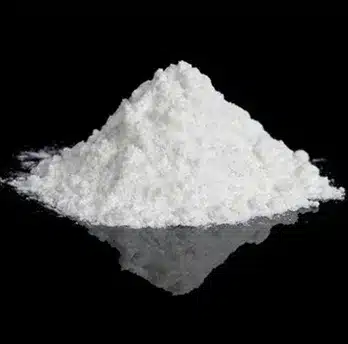Silicon dioxide is the main structural component of glass. It helps glass have high strength and good chemical stability. That’s why quartz sand is the most important industrial raw material in the glass industry. It is used in flat glass, container glass, ultra-clear glass, photovoltaic glass, quartz glass, and more.
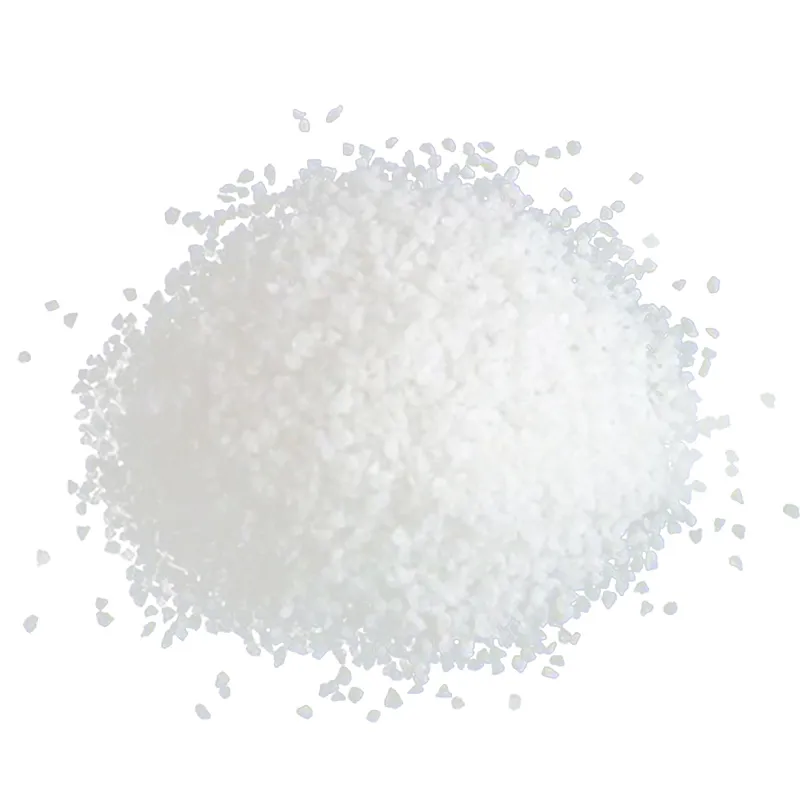
According to statistics, China’s flat glass production in 2023 was 969.418 million weight boxes. The quartz sand consumption was about 32.47 million tons.
Also in 2023, China produced 24.783 million tons of photovoltaic rolled glass. It takes about 0.71 tons of low-iron quartz sand to make 1 ton of photovoltaic glass, so the total quartz sand consumption was about 17.6 million tons.
Based on these numbers, China needed over 50 million tons of quartz sand just for flat glass and photovoltaic glass in 2023.
The quality requirements for quartz sand in the glass industry mainly focus on three things: chemical composition, stability, and particle size. Different types of glass need different types of quartz sand.
The main glass product types include flat glass, container glass, tempered glass, photovoltaic glass, and electronic glass.
Right now, China has lower requirements for quartz used in regular glass products like flat and tempered glass. These types of quartz can come from large, easy-to-mine sources like quartz sandstone and quartzite.
For low-iron, ultra-clear glass such as photovoltaic glass, the quartz sand needs to be of slightly higher quality. This can be produced from high-grade quartz sandstone, vein quartz, quartzite, or natural quartz sand.
Quartz glass needs high-purity quartz sand.
1. Flat Glass
Since 1988, China has been the world’s top producer of flat glass for 35 years in a row. Other countries have not yet caught up.
In 2024, China’s flat glass output by major enterprises is expected to reach 1 billion weight boxes, a 2.9% increase from the previous year.
Flat glass is the basic material used in further glass processing. It usually refers to common flat glass, also known as original or clear glass. It is the most widely used type of glass.
Flat glass products include wired glass, patterned glass, glass bricks, insulated glass, and others.
Different flat glass products have different quartz sand requirements. Based on chemical composition and particle size, quartz sand used in flat glass is divided into two grades:
Class I: lower aluminum oxide (Al₂O₃) content
Class II: higher aluminum oxide content
The industry standard JC/T 529-2000 “Silica Raw Materials for Flat Glass” sets requirements for the chemical composition, particle size, and other properties of quartz sand used in flat glass.
Chemical Composition and Moisture Content Requirements of Quartz Sand for Flat Glass
| Quartz Sand Grade | w(SiO₂)/% | w(Al₂O₃)/% | w(Fe₂O₃)/% | w(H₂O)/% |
|---|---|---|---|---|
| Class I | ||||
| Premium Grade | ≥98.50 | ≤0.50 | ≤0.05 | |
| ≥98.00 | ≤1.20 | |||
| First Grade | ≥98.50 | ≤0.70 | ≤0.10 | |
| ≥97.50 | ≤1.20 | ≤5.00 | ||
| Second Grade | ≥98.00 | ≤0.70 | ≤0.15 | |
| ≥96.50 | ≤1.50 | |||
| Third Grade | ≥98.00 | ≤0.70 | ≤0.20 | |
| ≥96.50 | ≤1.50 | |||
| Class II | ||||
| First Grade | ≥92.00 | ≤4.00 | ≤0.20 | |
| Second Grade | ≥90.50 | ≤4.50 | ≤0.30 |
Fluctuation Value Requirements of Chemical Composition in Quartz Sand for Flat Glass
| Quartz Sand Grade | Fluctuation Value of Chemical Composition % | ||
| SiO₂ | Al₂O₃ | Fe₂O₃ | |
| Class I | |||
| Premium Grade | ±0.20 | ±0.10 | ±0.01 |
| First Grade | ±0.30 | ±0.15 | – |
| Second Grade | ±0.30 | ±0.20 | – |
| Third Grade | ±0.30 | ±0.20 | – |
| Class II | |||
| First Grade | ±0.30 | ±0.20 | – |
| Second Grade | ±0.30 | ±0.20 | – |
| Quartz Sand Grade | Particle Size Composition / % | |||
| +1 mm | +710 µm | +500 µm | -100 µm(-125µm) | |
| Class I | ||||
| Premium Grade | ≤0(0) | ≤0.5(0.5) | ≤5.0 (5.0) | ≤5.0 (5.0) |
| First Grade | ≤0(0) | ≤0.5(0.5) | ≤5.0 (5.0) | ≤10.0 (5.0) |
| Second Grade | ≤0(0) | ≤0.5(0.5) | ≤5.0 (5.0) | ≤20.0 (8.0) |
| Third Grade | ≤0(0) | ≤0.5(0.5) | ≤5.0 (5.0) | ≤20.0 (8.0) |
| Class II | ||||
| First Grade | ≤0(0) | ≤0.5(0.5) | ≤5.0 (5.0) | ≤5.0 (5.0) |
| Second Grade | ≤0(0) | ≤0.5(0.5) | ≤5.0 (5.0) | ≤5.0 (5.0) |
Note: The values in parentheses are the requirements for natural silica sand products.
2. Daily Glass
Daily-use glass includes bottles, containers, lab glassware, and pharmaceutical glass. These are used for packaging in food, beverage, brewing, and pharmaceutical industries—for example, beer bottles, drinking glasses, glass decorations, and medicine bottles.
Pharmaceutical borosilicate glass must resist heat and chemical corrosion.
Quartz sand melts at a high temperature of about 1730℃. The particle size of quartz affects how the glass forms.
In actual production, quartz grains should be angular with a large surface area, which helps prevent separation of materials during mixing. The ideal particle size range is 60–140 mesh.
The industry standard DZ/T 0207-2002 “Specifications for Geological Exploration of Glass Silica Raw Materials” outlines the quality requirements for quartz sand used in container glass.
Quality Requirements of Quartz Sand for Container Glass
| Indicator | Grade 1 | Grade 2 | Grade 3 |
|---|---|---|---|
| w(SiO₂)/% | >99 | >96 | >90 |
| w(Al₂O₃)/% | <1.0 | <2.0 | <4.0 |
| w(Fe₂O₃)/% | <0.05 | <0.10 | <0.35 |
| w(Cr₂O₃)/% | <0.001 | — | — |
| Note: | Laboratory glassware (excluding crystal glass) | General container glass and colorless glass | Common bottle and jar glass |
3. Photovoltaic Glass
Photovoltaic glass is made from ultra-white glass sheets through deep processing.
Ultra-white glass, also known as low-iron or high-transparency glass, is a new type of glass with very high light transmittance (≥ 91.5%), low iron content (typically 100–150 ppm), and an extremely clear appearance.
Because photovoltaic glass must let in as much light as possible, it requires quartz sand with very low iron content. Iron in the sand can stain the glass and reduce light transmittance.
The industry standard JC/T 2314-2015 “Silicon Raw Materials for Photovoltaic Glass” sets strict quality requirements for quartz sand used in this type of glass.
| Parameter | Grade 1 | Grade 2 |
|---|---|---|
| SiO₂/% | ≥99.5 | ≥99.0 |
| Al₂O₃/% | ≤0.20 | ≤0.50 |
| TiO₂/(mg/kg) | ≤10 | ≤20 |
| Fe₂O₃/(mg/kg) | ≤60 | ≤80 |
| Cr₂O₃/(mg/kg) | ≤2 | ≤5 |
| 1.0 mm sieve residue/% | – | 0 |
| 0.6 mm sieve residue/% | ≤1.5 | ≤1.5 |
| 0.1 mm undersize/% | ≤5.0 | ≤5.0 |
| Adsorbed moisture/% | ≤5.0 | ≤5.0 |
The purity of quartz sand is measured mainly by its silicon dioxide (SiO₂) content. For photovoltaic glass, the required SiO₂ content is at least 99.99% (called 4N level), and some high-end products even require 99.998% (4N8 level).
This is much higher than regular glass, which usually needs SiO₂ ≥ 99.5%, because even tiny impurities can lower the glass’s light transmittance and reduce the efficiency of solar panels.
Some key requirements:
• Iron (Fe): Fe₂O₃ is a critical indicator, as iron affects color and transparency.
The JC/T 2314-2015 standard requires Fe₂O₃ ≤ 100 ppm, but many manufacturers control it below 50 ppm.
For ultra-white glass, Fe₂O₃ should be ≤ 0.015% (150 ppm), and high-end products often require ≤ 80 ppm.
• Titanium (Ti): TiO₂ ≤ 300 ppm. Too much titanium can turn the glass yellow and block light.
• Aluminum (Al) and Calcium (Ca): Al₂O₃ ≤ 100 ppm, CaO ≤ 0.1%. High amounts may cause crystal formation at high temperatures or affect how the glass melts.
• Alkali metals (K, Na): The total of K₂O + Na₂O should be ≤ 2.5 μg/g to prevent surface alkali buildup and conductivity problems.
• Trace elements: B ≤ 5 μg/g, Mn ≤ 1 μg/g. Heavy minerals like Cr and Ni must be ≤ 5 ppm to prevent defects or affect electrical performance.
The particle size of quartz sand also matters. It affects how evenly the glass melts and how much light it can pass through.
Quartz sand for photovoltaic glass should have a particle size between 70–350 μm, and at least 90% of the sand should fall within this range. If the particles are too small (<100 μm), they melt too early and reduce heat transfer.
If the particles are too large (>300 μm), they may not melt completely and cause bubbles or stones in the glass.
Typical classifying requirements for quartz sand for photovoltaic glass:
• 0.1–0.25 mm (100–250 μm): 5%–20%
• 0.25–0.5 mm (250–500 μm): 20%–35%
4. Electronic Glass
Electronic glass includes display substrate glass, high-strength cover glass, and ultra-thin touch screen glass. Examples include mobile phone covers, touch screens, and tablet displays. Most touch screen cover glass today is made of high-alumina silicate glass.
For example, the glass used in TFT-LCD (Thin Film Transistor Liquid Crystal Display) substrates must not contain alkali metal oxides. To ensure chemical stability and prevent harmful impurities, the quartz raw material must go through beneficiation and purification to control levels of Fe, K, and Na.
The company standard Q/245400 KS02-2020 by Kaisheng Quartz Materials (Huangshan Co., Ltd.) provides specific requirements for the particle size and chemical composition of high-purity quartz powder used in TFT-LCD glass substrates.
Table 1: Particle Size Distribution Requirements (Sieve Analysis)
| Parameter | +150μm (+100 mesh) | -150μm~+106μm (-100~+140 mesh) | -75μm~+45μm (-200~+325 mesh) | -45μm~+20μm (-325~+635 mesh) | -20μm (-635 mesh) |
| Standard | 0 | ≤2.5% | ≥70% | 22-30% | 0 |
Table 2: Laser Particle Size Analysis Requirements
| Parameter | D₁₀ (μm) | D₅₀ (μm) | D₉₀ (μm) |
| Standard | 30-35 | 56-62 | 88-98 |
Table 3: Chemical Composition Specifications
| Parameter | SiO₂ | Al₂O₃ | Fe₂O₃ | Na₂O+K₂O | SO₃ | TiO₂ | Cr+Ni+Co+Mn |
| Limit/% | ≥99.8 | ≤0.05 | ≤0.01 | ≤0.02 | ≤0.03 | ≤0.002 | ≤0.001 |
| Parameter | CaO | Cl | MgO | Cu | F | Zr | L.O.I |
| Limit/% | ≤0.02 | ≤0.001 | ≤0.003 | ≤0.001 | ≤0.001 | ≤0.001 | <0.1 |
5. Quartz Glass
Quartz glass is considered the “crown jewel” of glass materials.
It is made entirely from SiO₂ and has excellent mechanical, thermal, optical, and electrical properties.
Quartz glass is widely used in semiconductors, optical devices, fiber optics, solar energy, and more.
It has excellent light transmission across UV, visible, and infrared wavelengths (160–4500 nm), making it important for industrial lighting.
In optical instruments, quartz glass is used in spectrometers, infrared cameras, prisms, and lenses.
It can withstand very high temperatures, typically between 800–1000°C.
Optical quartz glass is also used in high-temperature photography equipment, such as observation windows, rangefinders, and large telescopes.
Quartz glass is made using high-purity quartz sand, processed through electric melting or gas refining methods.
Comparison of Quartz Material Production Processes
| Material | Natural Crystal/Quartz Sand | Natural Crystal/Quartz Sand | Silicon Tetrachloride | Silicon Tetrachloride |
| Process | Electric Fusion: Arc or vacuum pressure resistance heating | Gas Flame Fusion: Oxy-hydrogen flame melting | MCVD: Hydrolysis in oxy-hydrogen flame | PCVD: High-temperature oxidation in hydrogen-free plasma flame |
| Properties | – OH content: 150ppm – Al content: 30-100ppm – Alkali metals: 5-10ppm | – OH content: 180-250ppm – Al content: <20ppm – Alkali metals: <5ppm | – OH content: >1000ppm – H content: >100ppm – Metal impurities: <1ppm | – OH content: <5ppm – Impurities: <1ppm – N content: <200ppm – Transmission range: 0.18-3.5μm |
| Advantages | Lower OH content than flame fusion 50-100°C higher softening point than other methods | – High thermal efficiency – Low material loss – Few bubbles – Better UV transmission – Superior crystallization resistance – Longer lifespan – Lower production cost | – Ultra-low impurities – Excellent optical homogeneity – UV transmission – Radiation resistance | – Purity: >99.9999% – Extremely low OH content -Outstanding optical homogeneity |
| Disadvantages | Higher metal content | Higher OH content Lower softening point than electric fusion products | Excessive OH content High raw material cost | High raw material and production costs |
For example, high-purity quartz sand products from Sibelco (formerly Unimin)—such as the IOTA6, IOTASTD, and IOTACG series—are key materials for making lighting equipment like automotive xenon lamps, halogen lamps, high-intensity discharge lamps and ultra-high performance lamps.
Impurity Element Requirements for Quartz Sand in Quartz Glass Manufacturing
| Industrial Application | Origin | Major Impurity Elements & Content (ppm) | |||||||
| Al | Fe | Ti | Ca | B | K | Na | Li | ||
| Electric Light Source | China | Total: 50-100 ppm | |||||||
| Chemical Industry | Czech | 42 | 3 | 3 | 8 | – | 18 | 5 | – |
| Semiconductor | China | 20 | 0.18 | 0.5 | 0.1 | 0.1 | 0.2 | 4 | 1.8 |
| Semiconductor (High-grade) | USA | 15 | 0.3 | – | 0.4 | 0.1 | 0.7 | 0.9 | 0.7 |
| Russia | 14 | 0.9 | 0.4 | 0.1 | – | 0.3 | 0.6 | – | |
| Fiber Optic Tubes | Brazil | 11 | 1.8 | 0.4 | 0.1 | – | 0.3 | 0.4 | – |
| Optical Lenses | USA | 8 | 0.05 | – | 0.7 | 0.04 | 0.05 | 0.05 | 0.2 |

